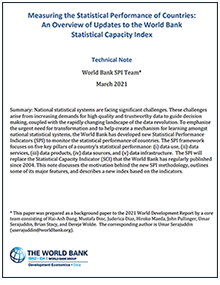The SPI shows where countries stand on each of the 14 dimensions, on each of the 5 pillars, and on the overall Statistical Performance Index, which replaces the World Bank’s Statistical Capacity Index, produced since 2004.
To build confidence in its objectivity, the SPI uses open data and open code. To track progress over time, the data will be updated in October of each year.
The methodology and analysis are included in the SPI research paper and SPI technical notes.
Research
Statistical performance indicators and index—a new tool to measure country statistical capacity
(Dang, Pullinger, Serajuddin, and Stacy)

Strong statistical capacity is a prerequisite for producing reliable statistics that helps monitor a country’s governance and economic performance. This is particularly relevant for a large number of poorer countries, which have weaker statistical capacity but have to rely more on these statistics for various objectives such as monitoring poverty reduction or reporting to international donors. We present the Statistical Performance Indicators and Index (SPI) as the World Bank’s new official tool to measure country statistical capacity. The SPI is conceptually motivated, builds on a mathematical foundation, and significantly expands the number of indicators and the number of covered countries compared to its predecessor. The new index has a strong correlation with other common development indicators such as GDP per capita, governance, human capital, poverty, and inequality. It can also accommodate future improvements as the global data landscape evolves.
Download the Paper
Statistical Performance Indicators and Index : A New Tool to Measure Country Statistical Capacity
(Dang, Pullinger, Serajuddin, and Stacy)
 The World Bank’s Statistical Capacity Index has been widely employed to measure country statistical capacity since its inception two decades ago. This paper builds on the existing advantages of the Statistical Capacity Index, conceptually and empirically, to offer new statistical performance indicators and the Statistical Performance Index, which can better measure a country’s statistical performance. The new index has clearer conceptual motivations, employs a stronger mathematical foundation, and significantly expands the number of indicators and countries covered. The paper further provides empirical evidence that illustrates the strong correlation of the new index with other commonly used development indicators of human capital, governance, poverty, and inequality. The framework can accommodate future directions to improve the index as the global data landscape evolves.
The World Bank’s Statistical Capacity Index has been widely employed to measure country statistical capacity since its inception two decades ago. This paper builds on the existing advantages of the Statistical Capacity Index, conceptually and empirically, to offer new statistical performance indicators and the Statistical Performance Index, which can better measure a country’s statistical performance. The new index has clearer conceptual motivations, employs a stronger mathematical foundation, and significantly expands the number of indicators and countries covered. The paper further provides empirical evidence that illustrates the strong correlation of the new index with other commonly used development indicators of human capital, governance, poverty, and inequality. The framework can accommodate future directions to improve the index as the global data landscape evolves.
Download the Working Paper
Measuring the Statistical Performance of Countries : An Overview of Updates to the World Bank Statistical Capacity Index
(Dang, Dinc, Dias, Maeda, Pullinger, Serajuddin, Stacy, and Wolde)

National statistical systems are facing significant challenges. These challenges arise from increasing demands for high quality and trustworthy data to guide decision making, coupled with the rapidly changing landscape of the data revolution. To emphasize the urgent need for transformation and to help create a mechanism for learning amongst national statistical systems, the World Bank has developed new Statistical Performance Indicators (SPI) to monitor the statistical performance of countries. The SPI framework focuses on five key pillars of a country’s statistical performance: (i) data use, (ii) data services, (iii) data products, (iv) data sources, and (v) data infrastructure. The SPI will replace the Statistical Capacity Indicator (SCI) that the World Bank has regularly published since 2004. This note discusses the motivation behind the new SPI methodology, outlines some of its major features, and describes a new index based on the indicators.
Download the Technical Note
World Development Report 2021: Data For Better Lives
 The World Bank’s World Development Report 2021: Data for Better Lives focuses on how data can improve the lives of poor people and advance development objectives. The report emphasizes the gaps in the availability, quality, and usability of public use data, which are highlighted by the SPI, and offers solutions for improving data systems. The WDR also calls for a new social contract that enables the use and reuse of data to create economic and social value, ensures equitable access to that value, and fosters trust that data will not be misused in harmful ways. The SPI working paper serves as a background report for the WDR 2021.
The World Bank’s World Development Report 2021: Data for Better Lives focuses on how data can improve the lives of poor people and advance development objectives. The report emphasizes the gaps in the availability, quality, and usability of public use data, which are highlighted by the SPI, and offers solutions for improving data systems. The WDR also calls for a new social contract that enables the use and reuse of data to create economic and social value, ensures equitable access to that value, and fosters trust that data will not be misused in harmful ways. The SPI working paper serves as a background report for the WDR 2021.
Read WDR 2021


